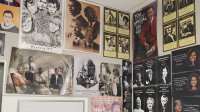If My Walls Could Talk
Teachers can enhance students’ sense of belonging with classroom decor that incorporates their cultural backgrounds.
I walked into my mentor teacher’s room during my very first year and remember feeling awestruck at the way his walls promoted diversity, equity, inclusion, and students’ sense of belonging. Through black-and-white photos, color posters, and intricate artwork depicting prominent people ranging from those in the literary canon to historical figures and jazz greats, his walls told a story, and like so many things he bestowed upon me, the welcoming space that he created for his students was one I vowed to emulate.
I quickly realized that we don’t have to limit ourselves to curriculum to make sure that our students are experiencing the diverse education they deserve. We don’t have to limit ourselves to monthly lesson plans based on cultural or religious celebrations that temporarily highlight equity and inclusion. We don’t have to limit ourselves or our students to what’s in a book for them to see themselves in our pedagogy. All of this can be achieved by what we choose to put on our classroom walls.
Diversity, Equity, and Inclusion
“We all should know that diversity makes for a rich tapestry, and we must understand that all the threads of the tapestry are equal in value no matter what their color.” —Maya Angelou
Our student body is multicultural and multilingual, and our students have various socioeconomic backgrounds. Nearly 90 percent of our students are minorities. Our school is a beautiful bouillabaisse of cultures, and I make every effort to include all of them on my walls.
Deaf students see themselves in deaf actor Michael Anthony Spady and deaf American Sign Language interpreter and performer Matt Maxey, aka Deafinitely Dope. Aspiring musicians and artists see themselves in Tupac Shakur. Students interested in science, technology, engineering, and math see themselves in Albert Einstein and Mae Jemison. Advocates of the power of student voice see themselves in Malala Yousafzai.
Those interested in law see themselves in Ruth Bader Ginsburg and Ketanji Brown Jackson. Those in the Muslim community see themselves in the multiple posters of Black and Brown women in hijabs. Many Latino students see themselves in Cesar Chavez and in the many images I include of Native Americans and sacred artwork in their culture.
My Asian and Pacific Islander students see themselves in my posters celebrating Chinese New Year. My walls epitomize the beautiful tapestry of diversity present in our school. I have accumulated so many posters and pieces of artwork that this celebration of diversity has spilled out into the halls that lead to my classroom.
My walls are not only the external manifestation of my 20-plus years of teaching, but also the legacy of the thousands of students who have entered my classroom. The archives of generations of students I have encountered over the years continue to live on in my classroom. So many alumni come to visit me often to catch glimpses of their younger selves and to view their often-decades-old poster projects. We also look back at club photos and mourn those we have lost, thankful that we have these captured memories.
Teachable Moments
I wrote a lesson a few years ago based on these walls that told a story. My students were tasked with walking around the room and just outside it to identify posters or pieces of wall art that resonated with them. Then, I asked them to choose three posters or examples of wall art that did one of the following things:
- Stood out to them
- Represented them
- They thought others would like
- They thought others would learn from
- Might encourage people to inquire about or ask questions
- They thought encouraged diversity or inclusion
The next part of the assignment was the most important to me: I asked them to tell me about a poster they would like to see on the wall and explain to me why they think it should be added. I focused on these answers, which often influenced the next posters I purchased.
- “I want to go to space one day”: I added a poster of Ellen Ochoa, the first female Latina astronaut.
- “Have you ever thought about adding more famous young people?”: I added a poster of poet Amanda Gorman.
Covering the Costs
I do not take for granted that very few teachers get recognized for the tireless work they put in by receiving teaching awards, especially those with monetary awards attached. One of the ways I have been able to decorate my walls is through these prestigious awards. I also write multiple grants specifically for culturally diverse, relevant, inclusive, and affirming artwork and posters.
Transparently, I have invested personal funds not only in the photos, posters, and artwork, but in laminations and pushboards to help with the preservation of these precious items. Of course, this was not done all at once, but this investment has added up to nearly the entirety of my classroom walls being beautified over the last two decades. My students’ identities are truly reflected in the walls of my classroom.
Passing the Torch
“Memories of our lives, of our works, and our deeds will continue in others.” —Rosa Parks
I still have several posters and framed photos that my mentor teacher passed down to me when he left teaching—a heavy framed wooden portrait of Black cowboys and a black-and-white cardboard poster of George Washington Carver, to name just two. But the most important thing he left me was the desire to make my classroom a place that my students looked forward to coming to, a place where they felt seen, and a place where learning came from not only the teacher in front of the room, but also the education they received from the walls.
